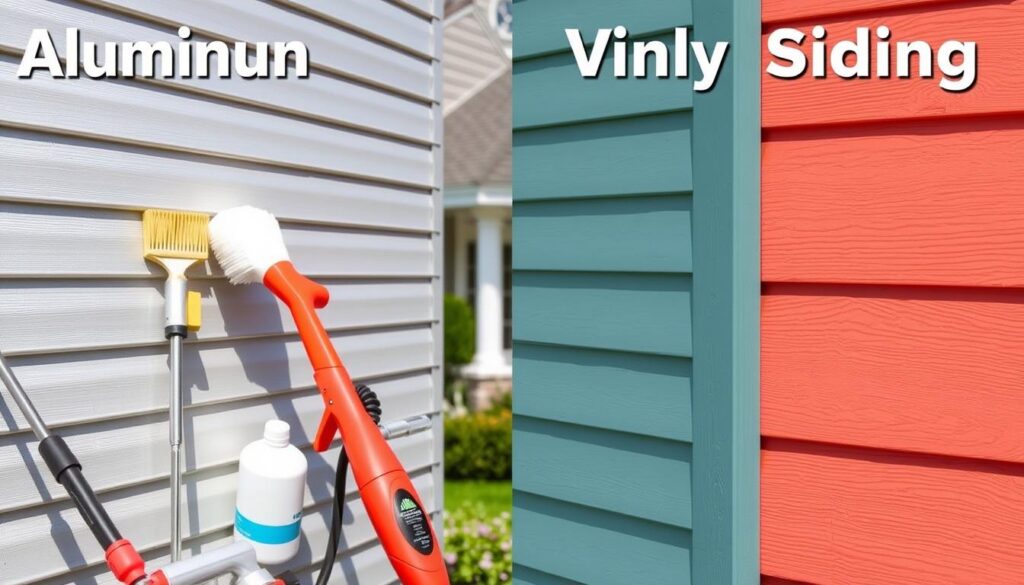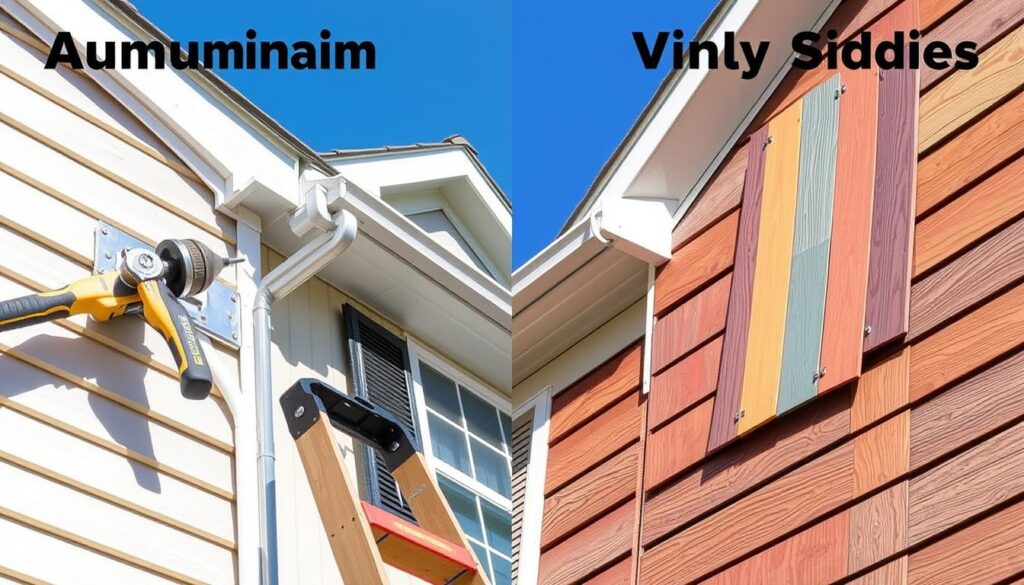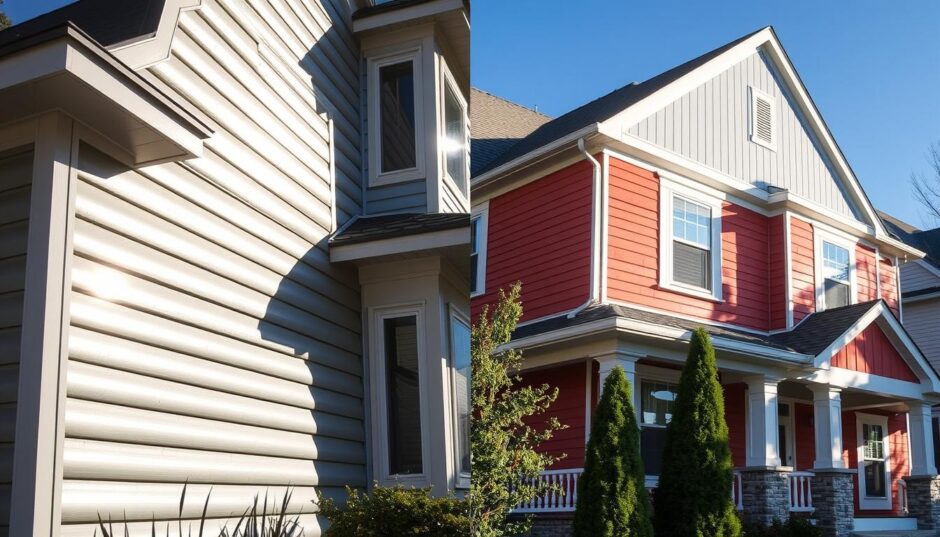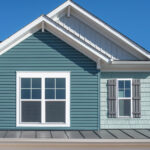Aluminum vs. Vinyl Siding Complete Comparison
When it comes to choosing the best siding options for your home, the decision can often feel overwhelming. Two of the most popular siding materials on the market today are aluminum and vinyl siding, each offering distinct advantages and disadvantages that can significantly impact the aesthetic and functional qualities of your property. Whether you’re looking to improve curb appeal, enhance energy efficiency, or increase the overall value of your home, understanding the differences between these siding materials is crucial. Consulting a skilled siding contractor can also provide insights tailored to your specific needs. In this complete comparison, we will delve into the features, benefits, and drawbacks of aluminum and vinyl siding, helping you make an informed decision that aligns with your vision for your home.
Home siding is key to a house’s look and protection. As far as types of siding aluminum and vinyl siding are top choices. We’ll look at their good and bad points to help you decide.
Key Takeaways
- Aluminum siding and vinyl siding are two popular home siding options.
- Vinyl siding accounts for approximately 30% of the residential siding market in the U.S.
- Aluminum siding has a global market share of around 14% in the siding industry.
- Both aluminum and vinyl siding offer unique benefits, including durability, low maintenance, and fire resistance.
- Homeowners should consider factors like cost, energy efficiency, and aesthetic appeal when choosing between aluminum and vinyl siding.
- Exterior siding, including aluminum and vinyl siding, plays a crucial role in protecting homes from the elements and enhancing their curb appeal.
- Understanding the differences between aluminum siding and vinyl siding is essential for making an informed decision.
Understanding Modern Siding Options
Choosing the right siding for your home involves looking at wood, metal, and vinyl options. Wood siding gives a natural look but needs more care. Metal siding is tough and fights off pests and fire.
Today, many want siding that’s easy to keep up. Fiber cement and vinyl siding are top picks for their durability and low upkeep. Eco-friendly choices like reclaimed wood and recycled metal are also gaining fans for their green benefits.
Evolution of Home Siding Materials
Aluminum siding became popular in the late 1940s as a wood alternative. Now, there’s a wide range of siding types, each with its own perks. Homeowners can pick from metal, wood, and vinyl to match their style and budget.
Current Market Trends in Exterior Siding
In 2024, homeowners and designers are into new, green, and stylish siding choices. Fiber cement, metal, and stone veneer are favorites. They’re durable, easy to care for, and look great, perfect for today’s homes.
The Fundamentals of Aluminum Siding
Aluminum siding has been a favorite for homes since the 1930s. It’s cheaper, easier to put up, fire-proof, and needs little care compared to wood. Today, it’s still a lasting choice, lasting many decades.
Aluminum siding stands up well against corrosion, making it a strong pick for different weather. It also needs less upkeep than wood, saving money over time. The cost of aluminum siding is between $3 to $8 per square foot, which is budget-friendly for many.
When thinking about siding installation, consider the weather, your budget, and how much care it needs. Aluminum siding can be painted, giving you design options without needing to replace it often. With the right metal siding installation, you can enjoy its benefits for years.
Important things to think about for home siding include the siding’s condition, project length, and coverage. You should also think about height issues and the tools you’ll need. Knowing the basics of aluminum siding and these points helps homeowners make smart choices for their siding installation.
All About Vinyl Siding Solutions
Vinyl siding is a favorite for house siding because it’s tough and easy to care for. It’s made from polyvinyl chloride, a material that’s both affordable and weather-resistant. Plus, vinyl siding doesn’t fade easily, thanks to its unique construction.
Many homeowners choose vinyl siding for its wide range of styles and textures. It’s also a smart pick for updating your home’s exterior. You can even put it over your current siding.
Composition and Manufacturing
Vinyl siding is made from polyvinyl chloride, a strong plastic. It’s created by extruding the plastic into shape and cutting it to fit. This makes it both durable and flexible, ready to handle wind, rain, and more.
Available Styles and Textures
Vinyl siding comes in many styles and textures, like lap siding and board and batten siding. These choices let homeowners pick the perfect look for their home. Some popular styles include:
- Lap siding: a classic style with overlapping panels
- Board and batten siding: a rustic style with wide boards and narrow battens
- Cedar texture shakes siding: a textured style that mimics the look of cedar shakes
Color Options and Customization
Vinyl siding is available in a wide range of colors, from traditional whites and beiges to bold blues and reds. You can also add trim and accents to make your siding truly unique. Vinyl siding makes it easy to give your home a personalized look that shows off your style.
| Style | Texture | Color Options |
|---|---|---|
| Lap Siding | Smooth | White, Beige, Gray |
| Board and Batten Siding | Rustic | Brown, Tan, Red |
| Cedar Texture Shakes Siding | Textured | Cedar, Weathered Wood, Driftwood |
Cost Comparison: Aluminum vs. Vinyl
Choosing between aluminum and vinyl siding involves looking at the cost. The siding costs change based on the material, installation, and upkeep. Generally, aluminum siding cost is lower than vinyl siding cost because it’s thinner.
The siding installation process also varies depending on the material used. Here are some important points:
Vinyl siding is generally easier and quicker to install.
Aluminum siding requires more precision during installation.
Heavy gauge metal siding can reduce removal efforts, leading to significant savings.
Think about the long-term maintenance costs too. Vinyl siding needs repainting every 10 to 12 years. Aluminum siding can last over 50 years with the right care. Plus, aluminum siding is fireproof, dent-resistant, and insect-proof, making it more durable.
Durability and Weather Resistance
Homeowners look for siding durability and weather resistance in their materials. Aluminum siding and vinyl siding are top choices, but they differ. Vinyl siding can melt or warp at high temperatures, while aluminum can get scratched or dented.
Vinyl siding becomes brittle in cold and can crack. Yet, aluminum siding handles extreme temperatures better. Still, it’s vital to install and maintain them well for weather resistance. Regular checks and cleanings can prevent damage and make the siding last longer.
Here are important points to think about when looking at siding durability and weather resistance:
- How well they handle extreme temperatures
- How they stand up to heavy rain and snow
- UV resistance and how well they keep their color
- How durable they are against impacts
By looking at these points and picking the right material for their climate and needs, homeowners can get a siding that’s both durable and weather-resistant. This will protect their home for many years.
| Siding Material | Lifespan | Weather Resistance |
|---|---|---|
| Vinyl Siding | 20-40 years | Resistant to moisture, but prone to warping and cracking |
| Aluminum Siding | 30-50 years | Resistant to extreme temperatures, but can be scratched or dented |
Maintenance Requirements and Care Tips
Regular siding maintenance is key to keeping your home’s exterior in top shape. You should check your siding every 6 months. This check-up frequency might increase if your siding material needs it.
Aluminum siding maintenance and vinyl siding maintenance have their own rules. This is because each material has its own special needs.
Homeowners can do simple tasks like cleaning with a hose and mild soap. But, for tougher problems, you might need a pro. Getting a pro to clean your siding can cost about $500. Yet, it’s a smart move to avoid expensive fixes later.

Here are some important tips for vinyl siding maintenance and aluminum siding maintenance:
- Look for cracks, warping, or fading regularly.
- Clean your siding every 6 months to 1 year to keep it looking good and lasting longer.
- Don’t use undiluted bleach, liquid grease remover, or furniture cleaners. They can harm your siding.
By following these tips and keeping up with siding maintenance, you can make sure your home’s exterior stays in excellent condition for many years.
| Siding Type | Maintenance Requirement |
|---|---|
| Vinyl Siding | Clean every 6 months to 1 year |
| Aluminum Siding | Inspect for damage, clean as needed |
Environmental Impact and Sustainability
Both aluminum siding and vinyl siding have their good and bad sides when it comes to environmental impact and sustainability. Aluminum siding needs very little energy to make and can be recycled. This helps cut down on waste and saves resources.
Vinyl siding, on the other hand, makes almost no waste during its creation. It can also be recycled into other products. The Vinyl Siding Institute says 99% of vinyl siding is recycled. This makes vinyl siding a greener choice.
Here are some important points to think about when looking at the environmental impact and sustainability of both:
- Vinyl siding makes 4 times less global warming than fiber cement.
- Vinyl siding also makes 2 times less acidification than fiber cement.
- Aluminum siding can be made from 30% recycled materials, saving new resources.
Choosing between aluminum siding and vinyl siding depends on what you value most. By looking at the environmental impact and sustainability of each, you can pick what fits your values and goals.
| Siding Material | Recyclability | Waste Reduction |
|---|---|---|
| Aluminum Siding | Highly recyclable | Reduces waste through recycling |
| Vinyl Siding | Recyclable into other products | Produces virtually no waste during production |
Installation Process and Considerations
When it comes to siding installation, several factors are important for a smooth process. The style, profile, and texture of the siding can change the price and installation complexity. For instance, aluminum siding installation needs extra care because it’s lightweight and doesn’t rust.
A good vinyl siding installation can cut energy costs by up to 20%. But, mistakes in siding installation can lead to water damage. This can cost between $500 to $3,000 to fix. It’s crucial to pick a reliable contractor for a proper installation process.

For a successful siding installation, consider these points:
* Make sure flashing is installed right to avoid water damage
* Overlap siding panels by at least 1 inch for better weatherproofing
* Keep the siding clean and well-maintained to make it last longer
By keeping these in mind, homeowners can get a durable and beautiful siding installation that adds value to their home.
Aesthetic Appeal and Design Options
Homeowners have many choices for siding design. Aluminum siding design and vinyl siding design are favorites. Vinyl siding looks like wood and comes in many colors to match any home.
Exterior design options include lap siding and board-and-batten siding. Lap siding has long boards that overlap. Board-and-batten siding gives a rustic look. Dynamic color schemes and advanced paints are also popular.
When picking siding design, consider:
- Texture and color options
- Style and pattern options, such as horizontal, vertical, or board & batten
- Material durability and resistance to environmental factors
- Energy efficiency and potential for energy savings
The best siding design depends on your taste, budget, and climate. By looking at different options, you can find a vinyl siding design or aluminum siding design that makes your home look great and saves energy.
Regional Considerations and Climate Factors
Choosing between aluminum and vinyl siding depends on your area and weather. Different places need different siding to last and handle the weather well. For example, in very cold areas, aluminum siding is better because it doesn’t get damaged by cold. Vinyl can get brittle in cold weather.
In humid areas, fiber cement and some vinyl types don’t warp or grow mold like wood does. Wood needs constant care to avoid decay. In hot places, metal siding can help keep your home cooler by reflecting sunlight and absorbing less heat.
It’s important to think about:
- Temperature changes
- Moisture levels
- Wind resistance
- Insulation
By looking at these factors, homeowners can pick the best siding for their home. This ensures a strong and lasting exterior.
Conclusion: Making Your Final Decision
After comparing aluminum and vinyl siding, we see both have their benefits. Aluminum siding is loved for its toughness, with 70% of homeowners choosing it. On the other hand, vinyl siding is better at saving energy, costing 15% less to cool than aluminum.
Maintenance costs are another key factor. Vinyl siding costs about $250 a year, while aluminum costs $375. Vinyl also lasts longer, up to 40 years, compared to aluminum’s 30 years. But, aluminum is more eco-friendly, with a 90% recycling rate, versus vinyl’s 5%.
Choosing between aluminum and vinyl siding depends on your needs and budget. Think about the upfront cost, ongoing maintenance, and how it affects your home’s energy use and value. By considering these points, you can pick the best siding for your home and lifestyle.







